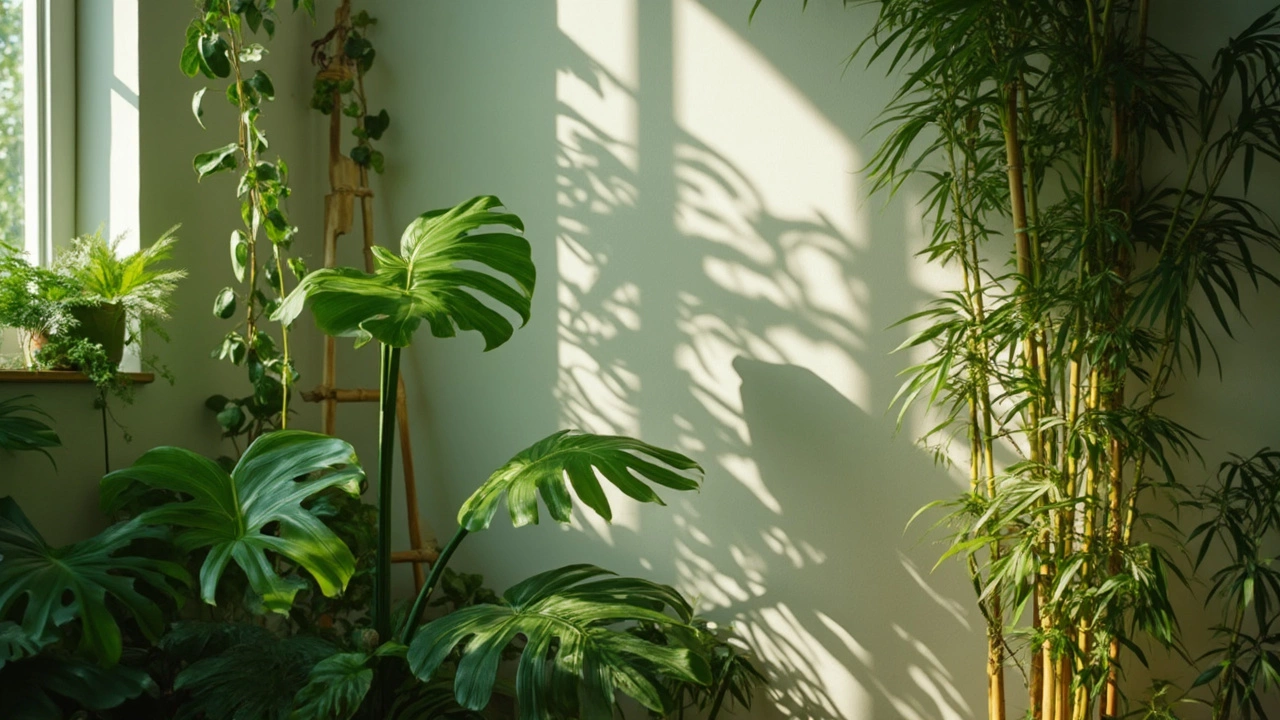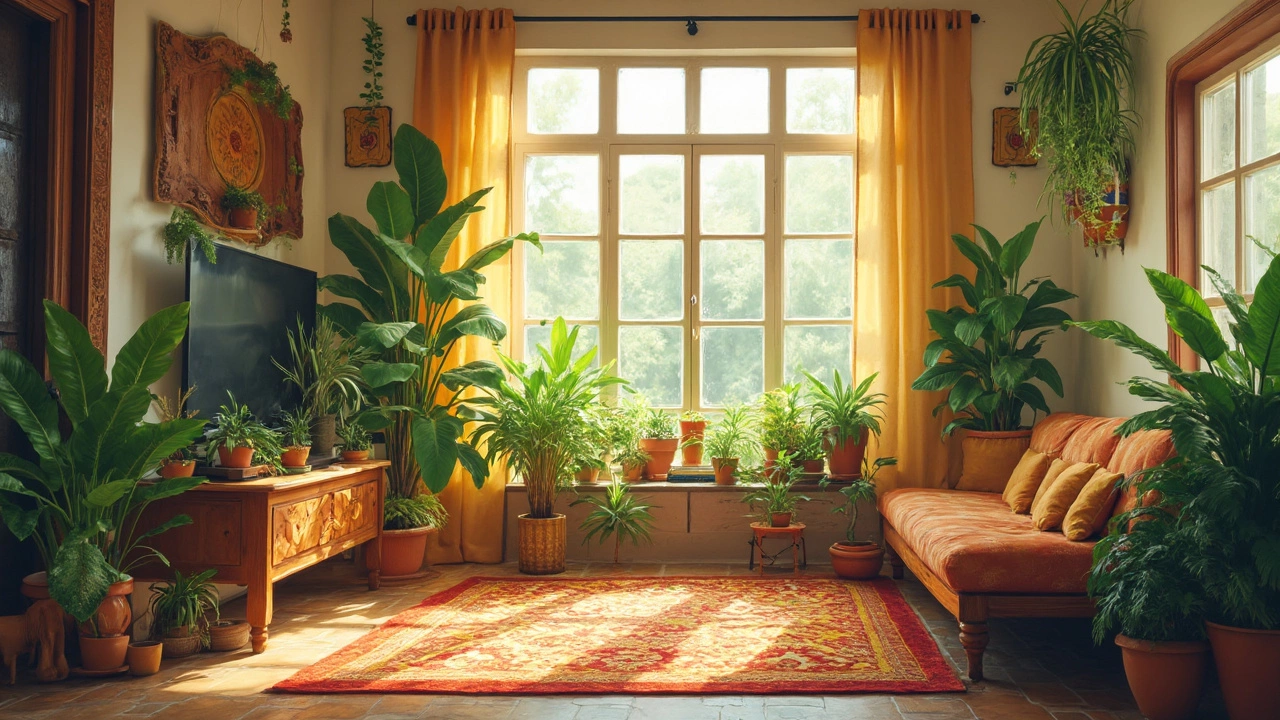Ever stepped into a room filled with plants and noticed how fresh the air feels? That's because certain indoor plants are known for their air-purifying abilities. At the top of the list is the Peace Lily, an elegant plant that not only brightens your space but is also a champ at cleaning the air. It’s known for removing toxins like ammonia, benzene, and formaldehyde. What's not to love?
But why do plants make such good air purifiers? Well, they absorb pollutants through their leaves and roots, turning harmful substances into food and clean oxygen. So, adding a few green friends to your home isn't just about aesthetics—it's a natural way to boost your air quality.
- King of Air Purifiers: The Peace Lily
- How Plants Improve Air Quality
- Easy Tips for Plant Care
- Top Contenders: Snake Plant and Spider Plant
- Placement for Best Results
- Troubleshooting Common Problems
King of Air Purifiers: The Peace Lily
When it comes to indoor plants that act like natural air filters, the Peace Lily stands out from the crowd. With its glossy green leaves and striking white flowers, it's a visual treat that also happens to excel at cleaning the air. This plant is a powerhouse at removing nasty stuff like ammonia, benzene, and formaldehyde from your environment.
Indoor plants like the Peace Lily have been shown to improve air quality significantly. According to NASA's Clean Air Study, the Peace Lily is one of the top plants for purifying air. Yep, even our friends at NASA are fans of its cleansing abilities!
"The Peace Lily is an excellent way to brighten up your space while absorbing pollutants," says Dr. Bill Wolverton, a scientist who led NASA’s landmark study on indoor air quality.
How It Works
The magic behind the Peace Lily's purifying power lies in its leaves and roots. The wide leaves absorb toxins and volatile organic compounds from the air, which are then broken down into harmless substances. It also helps maintain moisture levels in the air, acting almost like a natural humidifier.
Pro Tips for Care
Worried about caring for your Peace Lily? Don't be. They’re low-maintenance and perfect for folks who might not have the greenest thumbs. Just remember:
- Light: Peace Lilies thrive in low to medium indirect light. They aren't huge fans of direct sunlight, so keep them out of those hot spots.
- Water: It's easy with these guys. Just water them when the soil feels dry. And watch for droopy leaves—they’re a telltale sign that it's thirsty.
- Attention: Keep your Peace Lily away from drafts and heaters. They like stable environments.
If your plant blooms, consider yourself lucky! Those beautiful white flowers are the cherry on top of its air-cleaning abilities. Plus, they're known to warn you if something's off, like poor light or needing water.
How Plants Improve Air Quality
Alright, let's get into the nitty-gritty of how indoor plants work their magic on our air. First things first, plants are like nature’s air filters. They absorb toxins and turn them into lovely clean oxygen for us to breathe. It's like having a mini eco-friendly air purifier sitting on your shelf—and way prettier.
Understanding Airborne Toxins
Our homes are filled with airborne toxins from everyday products. Think about it—those cleaning sprays, synthetic fabrics, and even your comfy couch can emit harmful substances. This is where our leafy friends come in handy. They lift many of these nasties right out of the air.
The Process of Phytoremediation
Sounds fancy, huh? But it's simpler than it seems. Phytoremediation is basically how plants clean the air. They soak up pollutants through their leaves and roots, and thanks to their internal systems, actually transform these pollutants into nutrients. How cool is that?
NASA's Remarkable Findings
Way back in the late '80s, NASA conducted a study that revealed how certain indoor plants could improve air quality by removing toxins. This research highlighted a bunch of amazing plants, like the Peace Lily, for their ability to purify the air. So, if it’s good enough for space astronauts, it’s good enough for us!
Plants vs. Common Indoor Pollutants
- Formaldehyde: Found in paper products, and certain glues. Plants like the Spider Plant are champs at removing it.
- Benzene: Common in tobacco smoke and some detergents. English Ivy to the rescue!
- Ammonia: Present in cleaning products, and guess what? The trusty Peace Lily can tackle it.
By adding a few of these lovely indoor plants to your living space, you're taking a natural, cost-effective step toward healthier air. Plus, tending to plants can be pretty therapeutic, making it a win-win for your mind and body.
Easy Tips for Plant Care
Keeping indoor plants healthy is simpler than you might think, even if you're new to plant care. Here are some easy pointers to get you started.
Understanding Light Needs
First things first, know your plant's light requirements. Peace Lilies thrive in low to medium indirect light. Too much direct sunlight can scorch the leaves. If in doubt, place them a few feet away from a window. A great rule of thumb: if you can read a book by natural light in that spot, it's bright enough for most houseplants.
The Watering Game
Over-watering is a common mistake. Let the top inch of the soil dry out before giving your plants another drink. During the warmer months, they might need water once a week, while in winter, every two weeks might suffice. A good tip: water less frequently but more thoroughly. This ensures roots grow strong.
"Plants are like people; they have individual needs and thrive if you provide the right conditions," advises horticulturist Dr. Julie Wood.
Feed Them Well
Plants need nutrients to grow. Use a balanced liquid fertilizer once a month during the growing season (spring and summer). Avoid over-fertilizing as it can lead to nutrient burn.
Clean Those Leaves
Dust can accumulate on leaves, blocking sunlight and reducing the plant's ability to photosynthesize. Gently wipe them with a damp cloth once a month to keep them clean. It's a simple way to ensure your indoor plants are effectively maximizing their air purification.
| Task | Frequency |
|---|---|
| Watering | Once a week (Summer) |
| Fertilizing | Once a month (Spring/Summer) |
| Leaf cleaning | Monthly |
Implementing these tips will help your plants not only survive but flourish, providing cleaner air and a more vibrant living space.

Top Contenders: Snake Plant and Spider Plant
Let's talk about two fantastic choices for air-cleansing: the Snake Plant and the Spider Plant. These hardy plants aren't just easy on the eyes; they're superstars at improving air quality.
Snake Plant
Also known as Sansevieria or Mother-in-Law's Tongue, the Snake Plant is tough as nails and ridiculously low-maintenance. This plant doesn't need much light or water, making it ideal for beginners or busy folks. But what's really cool is its ability to filter out toxins like formaldehyde, xylene, and nitrogen oxides, going to work even at night. You can even pop it in your bedroom to keep the air fresh while you sleep.
Spider Plant
The Spider Plant, on the other hand, is just as easy to care for and sports a playful, bushy appearance. It quickly grows 'babies' or offshoots that you can easily repot and spread throughout your home. This plant is particularly efficient at removing carbon monoxide, xylene, and formaldehyde from the air. Plus, it absorbs these nasties even more effectively with a bit of bright, indirect sunlight.
- Lighting needs: Bright, indirect light works best for both but they're fine in low light too. Think of them as the easygoing roommates of the plant world.
- Watering schedule: Over-watering is a common mishap, so let the top inch of soil dry out before giving them a drink.
So, if you're looking to spruce up your space while also purifying your indoor air, the Snake Plant and Spider Plant are excellent choices. Give them a try and see how they do wonders for both the air and the vibe of your home.
Placement for Best Results
So, you’ve picked out the perfect indoor plants and now you're wondering where to place them? Here's the deal—placement can make or break their air-purifying potential. The right spot not only keeps your plants happy but maximizes their ability to clean your air.
Understanding Light Needs
Different plants have varied light requirements. For example, the Peace Lily thrives in indirect light, so it’s perfect for spots with filtered sunlight. Avoid direct sun; it can scorch those beautiful leaves. On the other hand, the Snake Plant is a trooper and can survive with low light, making it ideal for corners where other plants might struggle.
Room-by-Room Placement
Think about traffic areas. High-traffic rooms like your living room benefit from plants like the Spider Plant, which can purify air continuously. Bedroom? Go for plants known for night-time oxygen production, like the Snake Plant, to ensure fresh air as you sleep.
- Living Room: Keep a mix of plants at different levels—think floor, table, and shelves.
- Bathroom: Humidity lovers like the Boston Fern thrive here, helping to keep mold at bay.
- Kitchen: Consider herbs on the windowsill—dual purpose and delightful aroma.
Temperature and Humidity
Keep an eye on temperature and humidity. Most indoor plants are happy between 60-75°F (15-24°C). If you live in a dry climate, consider misting the leaves or grouping plants together to create a mini-humid environment.
Airflow Matters
Avoid placing plants right next to heating or cooling vents. The uneven airflow can stress them out. Instead, aim for a spot with a consistent gentle breeze—even placing a small fan nearby can help to circulate air and double your plant's air-cleaning potential.
Troubleshooting Common Problems
Just like any other aspect of life, keeping your indoor plants healthy isn't without its hiccups. Let's dig into common issues that might crop up and how you can nip them in the bud. First things first, check those browning leaves! They're often a sign of either too much water or too little. Regularly let the soil dry before you water again, but make sure it doesn’t dry out completely.
Yellow Leaves: Sign of Distress
Notice any yellow leaves? This could mean your plant is under stress. Overwatering is the usual culprit here, but it might also be due to poor light. Make sure your indoor plants get the right amount of indirect sunlight. By adjusting the light and water, many plants bounce back pretty quickly.
Wilting: What's Going on?
Wilting is another sign your plant might be unhappy. It's often caused by inadequate water. However, it can also be due to overwatering, causing root rot. Check the roots—if they're mushy, it’s time for a change in your watering routine.
"A key step is to understand the plant's native environment and try to mimic those conditions," advises Mark Cullen, well-known horticulturist and author.
Dealing with Pests
Spotting tiny bugs on your plant? Spider mites and aphids are common pests. Giving your plants a quick shower can help wash them away. Consistently inspect your plants, especially under the leaves, where pests love to hide.
Bonus Tips
Don't forget to rotate your plants so all sides get equal light. And remember, when in doubt, less is more. Over-care and attention often lead to most issues with indoor plant care.

